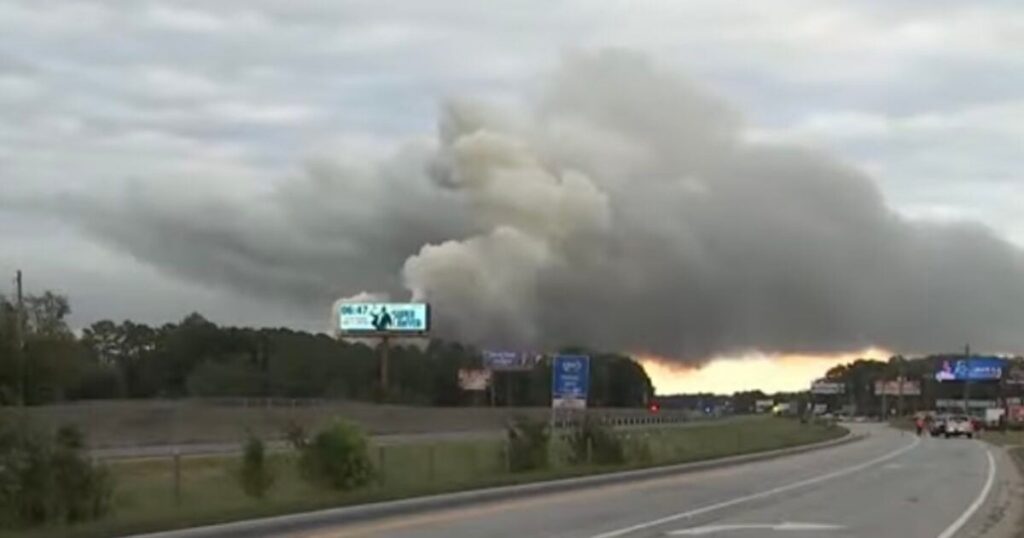🔴 Website 👉 https://u-s-news.com/
Telegram 👉 https://t.me/usnewscom_channel
Residents near Atlanta received additional warnings on Tuesday to shelter in place due to the remnants of the violent chemical reaction in Conyers.
A shelter-in-place order for Rockdale County ended on Monday but residents cited a strong chemical smell and hazy sky.
“Due to the weather, the plume is banking down and moving throughout the county. If the cloud moves over your vicinity, please shelter in place until the cloud moves out,” Rockdale County officials said, according to the Associated Press.
A chemical cloud moving around Atlanta’s suburbs prompts a new shelter-in-place alerthttps://t.co/iJk2xrmnyO pic.twitter.com/qn8I8z9fZL
— The Washington Times (@WashTimes) October 2, 2024
“Environmental officials are investigating a fire at BioLab, a chemical facility in Conyers, that sent a colossal wall of smoke that billowed into the air Sunday afternoon and led to the evacuation order of about 17,000 people and several road closures, including I-20, which remain closed Monday,” the Atlanta Journal-Constitution previously noted.
#BREAKING: A shelter-in-place order for all of Rockdale County has been extended indefinitely, authorities announced Monday morning.
Environmental officials are investigating a fire at BioLab, a chemical facility in Conyers, that sent a colossal wall of smoke that billowed into…
— Atlanta Journal-Constitution (@ajc) September 30, 2024
From the Associated Press:
Later Tuesday, Rockdale County emergency officials extended the timeline, recommending that residents shelter in place from 7 p.m. to 7 a.m. each night until Friday. They cited weather patterns in the evening and overnight hours, when air quality readings “may dip to concerning levels for those in direct exposure to the plume.”
The City of Atlanta said its firefighters continue to monitor the fallout, and urged anyone with “nose, throat or eye irritation, or difficulty breathing,” to call a Georgia Poison Center hotline.
“If you don’t have to be outside, if you don’t have to be on the roadways, stay home,” Rockdale County Board of Commissioners Chairman Oz Nesbitt said at a Tuesday morning news conference.
The fire was brought under control around 4 p.m. Sunday, officials said, but firefighters were still actively engaged Tuesday as the smoldering material kept sending up a plume of now grey-white smoke. The pollution “constantly shifted,” and with no strong prevailing wind to disperse it, smelly haze lingered across the Atlanta area.
“The EPA is monitoring air quality for chlorine and related compounds. Current data suggests that chemical levels in the air are unlikely to cause harm to most people. This data, along with further updates, will be shared with the public,” a prior statement from the EPA and Georgia EPD read.
“Please follow guidance from your county EMA. If you have concerns, limit your time outdoors, close windows, and turn off any ventilation systems,” the agencies advised.
Additionally, Georgia EPD and EPA advise: “Please follow guidance from your county EMA. If you have concerns, limit your time outdoors, close windows, and turn off any ventilation systems.”
— Atlanta-Fulton County EMA (@AFCEMA) September 30, 2024
Atlanta-Fulton County EMA posted this update Monday night:
Here is the latest information as of 9/30 at 8 pm, regarding the BioLab fire and expectations for Fulton County: pic.twitter.com/W6s0oHssBD
— Atlanta-Fulton County EMA (@AFCEMA) October 1, 2024
A closer look:
Per Newsweek:
Atlanta’s fire department is conducting tests for chemicals including chlorine, hydrogen sulfide, and carbon monoxide, while the U.S. Environmental Protection Agency (EPA) monitors for chlorine and related compounds.
Federal officials have opened an investigation into the fire’s cause and the response.
Rockdale County Fire Chief Marian McDaniel indicated that the fire started when the sprinkler system activated and doused water-reactive chemicals early on Sunday morning.
No injuries were reported among the employees present at the time.
Residents north of Interstate 20 were ordered to evacuate, while others were instructed to shelter in place. Reports of haze and a strong chlorine smell extended to Atlanta’s densely populated eastern suburbs in DeKalb and Gwinnett counties.
After several hours, DeKalb emergency management authorities assessed that the air pollution was “unlikely to cause harm to most people,” recommending that those concerned could seal their homes and turn off air conditioning units.
The EPA noted that chlorine has a very low odor threshold, allowing people to detect it at concentrations that pose no significant health risks.
The Conyers facility, operational since 1973, has a history of destructive fires. A May 2004 incident involving multiple explosions led to a massive fire that required the evacuation of 300 people as a chlorine cloud spread through the area, prompting at least nine hospital visits for symptoms like burning eyes and lungs.
WATCH:
